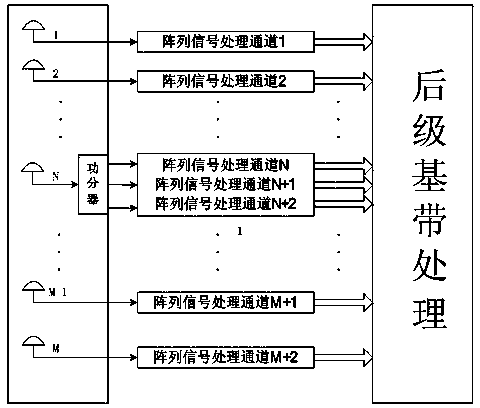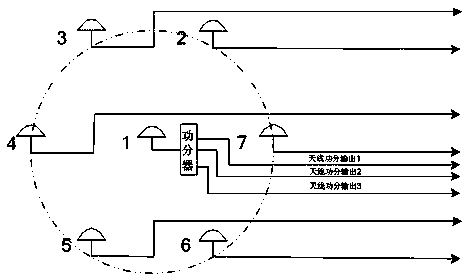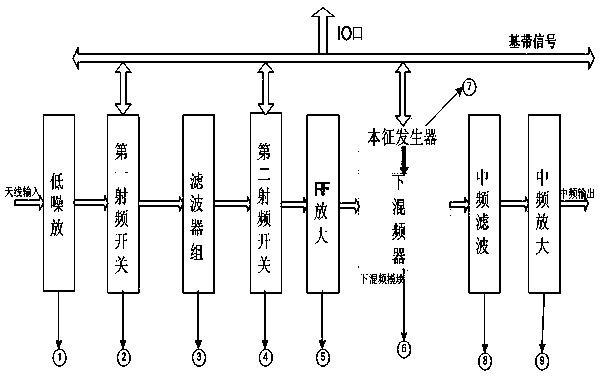Anti-interference GNSS receiver device combining multiple modes and multiple frequencies with array processing
An array processing, multi-mode and multi-frequency technology, applied in the field of satellite navigation, can solve problems such as the limit of array processing capacity, low utilization rate of antenna and radio frequency channel resources, etc., achieve high engineering practical value, improve anti-jamming and positioning performance, and accuracy high effect
- Summary
- Abstract
- Description
- Claims
- Application Information
AI Technical Summary
Problems solved by technology
Method used
Image
Examples
Embodiment 1
[0041] When interference does not exist, the working process of the device of the present invention is as follows:
[0042] The signal processing channel of the baseband control array outputs 8 kinds of intermediate frequency signals of GNSS signals with different frequency points. For example, the first array signal processing channel outputs GPS L1 intermediate frequency signals, and the second array signal processing channel outputs Beidou B1 intermediate frequency signals.
[0043] Take the first array signal processing channel as an example to illustrate how to control the output of GPS L1 intermediate frequency signals. The signal that enters the first array signal processing channel also contains the 8 kinds of GNSS signals output by the antenna array. First, the 8 kinds of GNSS signals are amplified by the low noise amplifier; then, the first radio frequency switch controls the 8 kinds of GNSS signals according to the baseband control. The signal is sent to the GPS L1 freq...
Embodiment 2
[0047] When interference exists, but the frequency points that cannot be located due to interference are less than 3, at this time, the interfered frequency point signal can be discarded by frequency selection, specifically: the signal processing channel in the array signal processing channel that receives and processes the interference frequency point The first radio frequency switch 1 performs a bypass and shuts off the processing of the interfered frequency signal in the baseband to save power consumption.
[0048] When there are 4 frequency points that cannot be located due to interference, the working process of the device of the present invention is as follows:
[0049] Record the frequency points that cannot be located due to interference and the frequency points that can be located. Mark the frequency points that cannot be located as f1, f2, f3, f4, and the frequency points that can be located as f5, f6, f7, and f8. Configure the array signal processing channels correspondi...
Embodiment 3
[0057] When interference exists and the frequency points that cannot be located due to the interference are greater than 4 but less than 8, the method of embodiment 2 is used for anti-interference processing, that is, the frequency points that cannot be located are marked as f1, f2, ..., fi, 4≤i<8; configure the array signal processing channels corresponding to antenna 1 power division output 1, antenna 3, antenna 5 and antenna 7 to the same frequency point, and the configured frequency points are f1, f2,..., fi One of the points uses a four-channel anti-jamming algorithm to perform anti-jamming processing on the output frequency points of the four-array element signal processing channel.
[0058] When all frequency points are interfered and cannot be located, the power division output of antenna 1 1, antenna 3, antenna 5, and antenna 7 are used as the first group, and the four-channel anti-interference algorithm is used for the array signal channel corresponding to the first grou...
PUM
 Login to View More
Login to View More Abstract
Description
Claims
Application Information
 Login to View More
Login to View More - R&D
- Intellectual Property
- Life Sciences
- Materials
- Tech Scout
- Unparalleled Data Quality
- Higher Quality Content
- 60% Fewer Hallucinations
Browse by: Latest US Patents, China's latest patents, Technical Efficacy Thesaurus, Application Domain, Technology Topic, Popular Technical Reports.
© 2025 PatSnap. All rights reserved.Legal|Privacy policy|Modern Slavery Act Transparency Statement|Sitemap|About US| Contact US: help@patsnap.com



